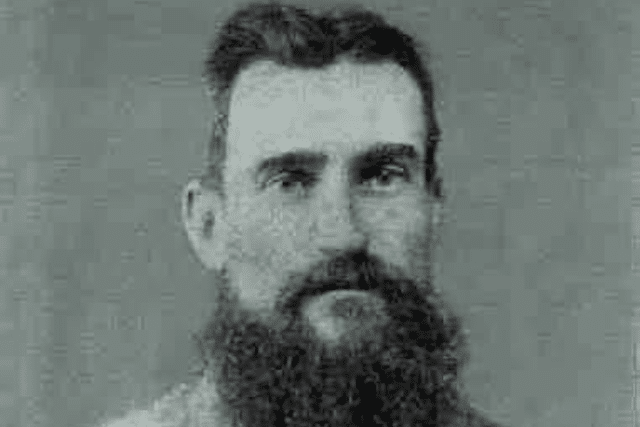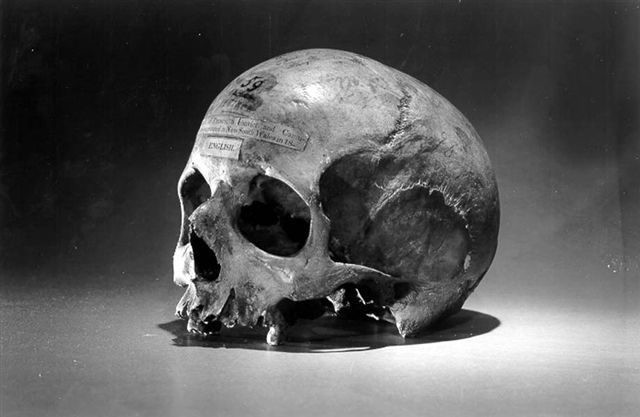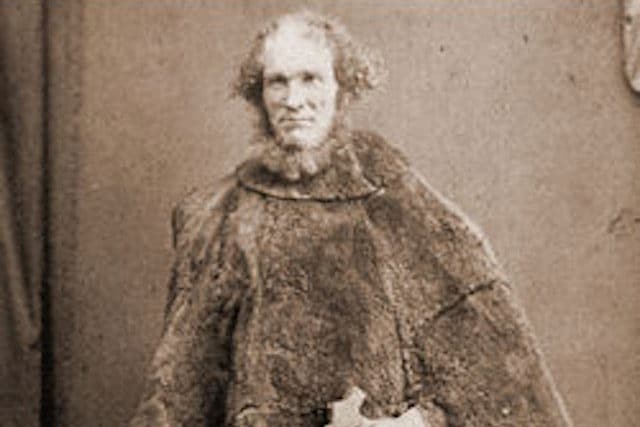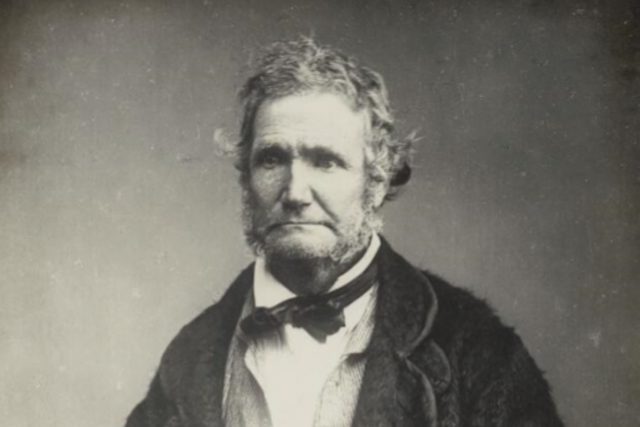The Wild West of the United States sets the stage for famous gunslinger films, but Australia is a land where convicts were exiled, creating the opportunity for new lives of crime to get established. Today, we profile the most notorious (and some lesser known) colorful miscreants in Australian history…
10. “Mad Dog” Daniel Morgan

With a short and violent career, “Mad Dog” Daniel Morgan, born in 1830 in New South Wales, was an unpredictable outlaw. Unlike many bushrangers who became folk heroes, this madman of Australia behaved more like a war criminal. Ranging across Victoria, the widely despised Morgan ended up with a bounty of a thousand pounds on his life. He hated the police so much that he injured a man’s wife badly by forcing her into a fire just because the man was too friendly to law enforcement for Morgan’s liking.
“Mad Dog” was known for taking hostages. In one case, he made Chinese hostages sing for his entertainment due to his curiosity over the foreign language, then shot one in the arm. In another situation, he let a female hostage go free because he was so impressed at her gumption when she out and out slapped him across the face. This incident would be his last, for soon after letting the hostage go, she summoned help, which came as a combined force of police and armed neighbors of the victims. Morgan appeared with three hostages, but was soon shot to death. Beheaded after death, he became the subject of phrenological study after a death mask was fashioned from his face.
9. “Captain Thunderbolt” Frederick Wordsworth Ward

The longest free roaming bushranger in Australia’s history, “Captain Thunderbolt” Frederick Wordsworth Ward, upheld better conduct than most bushrangers, earning him the nickname “the Gentleman Bushranger.” Born in 1835 in New South Wales, the somewhat respected outlaw was the son of convict Michael Ward and the youngest of the 10 children Ward senior had with his wife Sophia. After being sentenced to the harsh prison conditions on Cockatoo Island for his role in theft, namely receiving stolen horses, Ward faced 10 years but was released early on account of his model behavior.
Ward became involved with a woman named Mary Ann Bugg, who was of partially of Aboriginal Australian heritage, and the couple had two children. However, the conditions of his release were broken when he failed to return for his quarterly muster, a requirement comparable to parole. Therefore, he was returned to Cockatoo Island to serve out the remainder of his sentence in full, plus three years for riding a stolen horse. His escape from Cockatoo Island included a chase where he was shot in the leg but survived. In the end, “Captain Thunderbolt” was fatally shot at Kentucky Creek on May 25, 1870. The outlaw’s death was only the beginning of the legends.
8. Alexander Pearce

Originally sent to Australia for stealing shoes, Alexander Pearce was a bushranger with one creepy backstory. Pearce became a notorious cannibal bushranger in Australia following his humble start as a petty criminal. Born in 1790 in Ireland’s County Monaghan, Pearce ended up in what is now Tasmania (then called Van Diemen’s Land) following his 1819 sentence. He began a string of crimes in his new location of exile before being arrested again and sent to the Macquarie Harbor Penal Colony on tiny Sarah Island. After Pearce and seven more convicts escaped the colony, conditions were tough.
Starvation tough, in fact. Survival became increasingly difficult until, reportedly, the escaped men began to kill and devour each other. By alliance, brute force, and by luck, Pearce ended up being the sole survivor of the hungry massacre until his recapture. Body parts were found in his pockets, and Pearce was to be Tasmania’s first person to confess to cannibalism. Before being hanged at the Hobart Town Gaol on July 19, 1824, Pearce is said to have described cannibalism in the following glowing terms: “Man’s flesh is delicious. It tastes far better than fish or pork.”
7. Mark Brandon “Chopper” Read
A more modern outlaw in contrast to the rest of these accounts, Mark Brandon “Chopper” Read was one of the most violent men in Australia’s history, carrying out gangland killings and torture that would have branded him a war criminal had he been in a nation’s armed forces. In addition to his acts of violence in Australia’s underworld that including cutting or burning off the toes of his enemies and allegedly murdering targets, Read was also a children’s book author.
Released from Pentridge Prison in Melbourne in November of 1991 under a shroud of secrecy when his sentence for arson, criminal property destruction, and shooting a drug dealer ended, this “urban bushranger” diversified his portfolio, developing a side business of selling paintings. Interestingly, he has swung between dismissive comments about Ned Kelly (who was also imprisoned at Pentridge), describing him as overrated, and also hailed the notorious bushranger as a folk hero like many do. When it comes to “Chopper’s” paintings, Ned Kelly often appears, albeit with the type of tattoos sported by the painter himself. The works of the outlaw painter can fetch high prices at over 6,000 Australian dollars each. A movie about the notorious criminal, who died in 2013, was released in 2000 starring erstwhile “Hulk” Eric Bana.
6. “Bold Jack” John Donohoe

A folk hero for his bravado against the law, “Bold Jack” John Donohoe was Irish born but transported to Australia after being convicted for ‘intent to commit a felony’. Once in Australia, “Bold Jack” and two associates robbed multiple bull teams hauling goods along the road between Windsor and Sydney. All three were rather harshly sentenced to death for their property crimes — not once, but twice. Bold Jack wasn’t having any of it, escaping from his captors and fleeing for his life. For the following two and a half years, the outlaw survivalist became Australia’s most famous bushranger.
He did not cower as stayed one step ahead of the law, but continued his exploits with his gang of assorted bushrangers dedicated to plundering and wilderness survival. A reward had been put up, but with little result. By September 1830, a combined force of soldiers and police officers caught Bold Jack and his gang at the outskirts of Cambelltown. Donohoe taunted the police during the confrontation, using highly insulting language. Eventually, he was fatally shot by Trooper Muggleston. After his death, the legend lived on, with art completed in his honor and folk songs written about his short life.
5. Harry Power

Harry Johnson, known by the alias Harry Power, was an Irishman well known to the police for petty crimes until he got a 14-year sentence at Pentridge Prison for stealing a horse. He is known for being something of an outlaw mentor to Ned Kelly, whom he visited when Kelly was a boy, but also as a “gently ruthless” bushranger. By that we mean he took what he wanted and ran to freedom but, importantly, he never ended a human life. The gruff looking man was quite clever, with exceptionally humorous aspects to his most daring escapes. With regard to that 14-year sentence for stealing a horse, Harry Power was just not up for it so he escaped in a cart piled with garbage.
Later, when three young men encountered the outlaw and declared their intention to arrest Harry Power… without realizing they were talking to Harry Power. The wanted man pretended to be desperately terrified of this rogue bushranger. To throw them further off the truth that their quarry was standing right before them, Power requested that they protect him from this lawless man. Joining them, he soon robbed them of everything they had — weapons, clothes, and all — and sent them home in the nude. Power was sentenced to another 14 years in Pentridge when he stole a golden watch, then hired an agent to tell the owner he could have it back at triple its original price. Unfortunately for Power, the agent lead police straight to him. After his release, Power took jobs including gameskeeping and ship duties, but was penniless upon his death in 1891.
4. John Anderson

Known in his day as “Black Jack,” John Anderson was a brutal yet often charismatic outlaw was African-American but became Australia’s only known pirate. He is known for robberies backed with death threats, killing Aboriginals and enslaving tribe member women. The pirate might be considered something of a coastal “bushranger,” original hailing from Massachusetts, where he worked as a whaler. He took a trip to Australia on the ship The Vigilant, arriving in 1826 in what is currently known as Albany in Western Australia.
Quickly blamed for the death of a ship’s crewman from a different vessel in a store, Black Jack fled, stole a boat with several crew members, and got to the Recherche Archipelago. There they settled and hunted seals, selling their skins, and also pillaged ships loaded with supplies on their way to Hobart and Sydney. Black Jack is described in court records dating to 1835 as a “master of a sealing boat” who took money from sailors who would be murdered if they refused to give up their currency. It is believed that John Anderson was slain by his crew members, with his body and buried treasure hidden in the elaborate limestone cave systems of Middle Island, the settling place of the pirate gang.
3. Joseph Bolitho Johns, AKA “Moondyne Joe”

Joseph Bolitho Johns was born in England in 1826, living until 1900 was the best known outlaw of Western Australia. The notorious English convict was better known as “Moondyne Joe,” named after the Avon Valley, a remote region of the Darling Range that was called “Moondyne” by the Aboriginal Australians. The crime that got him arrested in 1848 was not huge — stealing about two days worth of meat and bread from a house — but Johns’s attitude toward the judge was significant, to say the least. The punishment was equally grand, with four years served in an English prison followed by a ticket to Western Australia.
After arrival he was granted conditional parole, with work as a horse trapper soon to follow. However, nothing had changed and the fledgling bushranger stole a horse, was arrested, then escaped on the same horse that was being held as evidence (albeit fitted with riding gear stolen from the judge himself). The following years saw repeat offenses, followed by either good behavior or a baffling escape. A special escape-proof cell was set up, but the tricky bushranger got away from that lockup as well. While paroled later on, Moondyne Joe married a widow and stayed on the straight and narrow before running afoul of the law yet again 20 years later. He got old for a bushranger, dying of dementia at 74.
2. Martin Cash

Martin Cash was originally from Ireland, where he committed the crime of housebreaking, for which he received a seven-year sentence. Cash’s personal claim was that his crime actually involved shooting a man in the rear when the man was kissing Cash’s own mistress. Upon being sent to Australia for his misdeed, he became known for his exceptional escape skills and also for marrying a female convict. Cash obtained a ticket of leave, but was soon arrested again, being sentenced to seven more years for theft. He escaped an incredible three times from Port Arthur, but was returned with four years of additional sentencing after being on the lam for two years after one of his escapes. Then, Cash made another escape, going with two bushrangers who helped him avoid prison guards.
Stealing from residences and inns gave the small gang a reasonable living, while their non-violent methods of extracting bounty added to their reputation — so much so that when Cash visited Hobart Town and was soon caught, public pressure helped his death sentence for slaying a pursuer be commuted to transportation for life, with 10 years at Norfolk Island. In 1854, Cash was allowed to marry County Clare convict Mary Bennett. Cash was renowned for hat making. In 1856, he was conditionally pardoned and traveled to New Zealand for four years. Upon his return, he recruited a writer to prepare his biography.
1. Edward “Ned” Kelly

The most notorious gunman in Australian history, Ned Kelly needs no introduction. Still, no list about Australian outlaws would be complete without Ned, so let’s profile some lesser known facts about the man in the metal mask. Born in 1855 and executed in 1880, Ned came from a large family. His father was a livestock thief from Ireland who married his employer’s daughter, with whom he had eight children. The notorious Ned was one of their three boys. The family of his mother was under investigation for livestock thefts, and soon Ned was not only working but helping to encroach on land and eventually steal livestock. Visits from police stoked the perception of police persecution held by the Kelly family. While Ned was an honorable boy, even saving the life of another young boy, in adulthood he strayed significantly, allegedly assaulting a Chinese man and spending a few days in jail over the incident.
When his alcoholic father died, Kelly joined his new stepfather in nefarious activities, ultimately spending three years in prison for accepting a stolen horse from an accomplice. After an unconfirmed claim that Ned Kelly had shot and injured a police officer, Kelly and his gang were classified as wanted outlaws and put up for reward, ending up on the run across Australia’s outback. In an ensuing shootout, the bushranger killed a police officer named Thomas Lonigan, then another, and even took a police station captive with his gang. A wild showdown ensued when the Kelly Gang confronted their pursuers in terrifying and medieval-looking armor fashioned out of ploughshares. After gang members killed a police informant and besieged a train station, 60 people were taken hostage at the Glenrowan Inn, which was set on fire by police after the hostages were released. The gang was also under the influence of alcohol, causing them to attack recklessly. Upon capture after being shot in the legs following his escape from the fire, Kelly was sentenced to death for police murder.